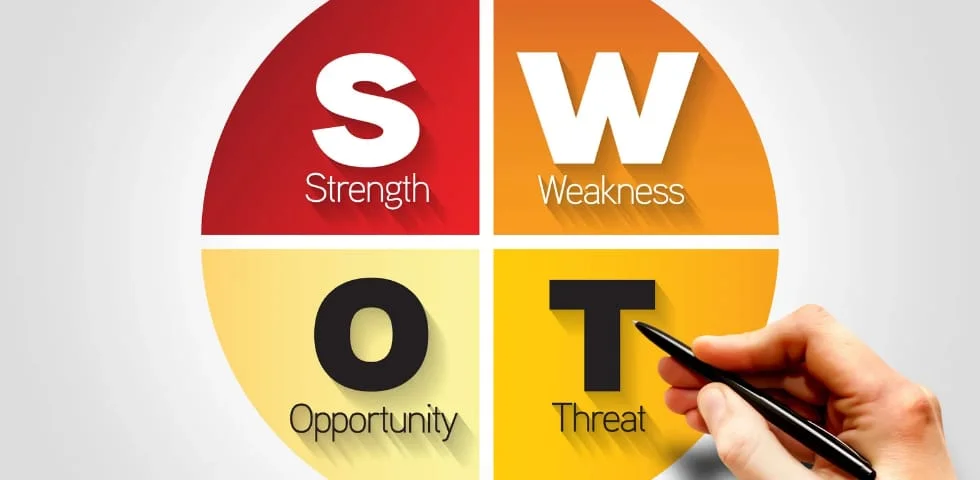In today’s competitive business landscape, understanding your organization’s strengths, weaknesses, opportunities, and threats is crucial for strategic planning and growth. A SWOT analysis is a powerful tool that helps businesses identify these key factors and develop strategies to enhance their competitive edge.
A SWOT analysis is not just a theoretical exercise; it’s a practical approach that can drive significant improvements in your business operations and strategic direction. Whether you’re a seasoned business owner, a manager looking to refine your strategy, or a student aiming to understand business analysis better, this guide will provide you with a comprehensive, step-by-step approach to conducting an effective SWOT analysis.
In this article, we’ll delve into the concept of SWOT analysis, explore its benefits, and provide you with detailed steps and practical tips to carry out your own SWOT analysis. By the end of this guide, you’ll be equipped with the knowledge and tools to identify your business’s strengths and weaknesses, uncover opportunities, and mitigate threats, paving the way for informed decision-making and strategic planning.
What is a SWOT Analysis?
A SWOT analysis is a strategic planning tool used to identify and understand the internal and external factors that can impact the success of a business. SWOT stands for:

- Strengths: Internal attributes and resources that support a successful outcome.
- Weaknesses: Internal attributes and resources that work against a successful outcome.
- Opportunities: External factors the organization can capitalize on or use to its advantage.
- Threats: External factors that could jeopardize the organization’s success.
Definition and Purpose
At its core, a SWOT analysis helps businesses gain a clear understanding of their current position in the market. By identifying and analyzing these four elements, companies can formulate strategies that leverage their strengths, mitigate their weaknesses, capitalize on opportunities, and defend against threats. This process not only aids in strategic planning but also enhances decision-making, ensuring that business leaders can respond proactively to changing market conditions.
Historical Background
The concept of SWOT analysis was developed in the 1960s by Albert Humphrey at the Stanford Research Institute. It was part of a project to identify why corporate planning failed. Humphrey’s research led to the creation of a simple yet effective framework that businesses could use to assess their strategic position. Since then, SWOT analysis has become a widely adopted tool in business strategy, used by organizations of all sizes and across various industries.
With a firm grasp of what a SWOT analysis is and its historical context, let’s explore the benefits of conducting a SWOT analysis in the next section.
Benefits of Conducting a SWOT Analysis
A SWOT analysis offers numerous benefits that can significantly enhance an organization’s strategic planning and decision-making processes. By systematically evaluating strengths, weaknesses, opportunities, and threats, businesses can develop a more comprehensive understanding of their internal and external environments. Here are some key benefits of conducting a SWOT analysis:

Strategic Planning
One of the primary benefits of a SWOT analysis is its ability to inform strategic planning. By identifying strengths and weaknesses within the organization, as well as opportunities and threats in the external environment, businesses can develop targeted strategies that align with their overall objectives. This ensures that resources are allocated effectively and efforts are focused on areas with the highest potential for impact.
Identifying Core Strengths and Weaknesses
A SWOT analysis helps organizations pinpoint their core strengths and weaknesses. Strengths can include factors such as a strong brand reputation, skilled workforce, or proprietary technology. Weaknesses might involve limited financial resources, outdated technology, or gaps in expertise. Understanding these elements enables businesses to leverage their strengths to their advantage and address or mitigate their weaknesses.
Exploring Opportunities and Threats
SWOT analysis also plays a crucial role in identifying opportunities and threats in the external environment. Opportunities might include emerging market trends, technological advancements, or changes in regulatory policies that could benefit the business. Threats could involve competitive pressures, economic downturns, or shifts in consumer preferences. By recognizing these factors, organizations can proactively develop strategies to seize opportunities and protect against potential threats.
Enhancing Decision-Making
The insights gained from a SWOT analysis can significantly enhance decision-making processes. Business leaders can use the information to make informed choices about investments, product development, marketing strategies, and other critical areas. This leads to more strategic and confident decision-making, ultimately driving better business outcomes.
Facilitating Communication and Collaboration
Conducting a SWOT analysis often involves input from various stakeholders within the organization, such as employees, managers, and executives. This collaborative approach fosters communication and ensures that diverse perspectives are considered. The resulting analysis provides a shared understanding of the organization’s position and fosters alignment around strategic goals.
Steps to Conduct a SWOT Analysis
Conducting a SWOT analysis involves a structured approach to thoroughly evaluate your organization’s internal and external environments. Here’s a step-by-step guide to help you perform an effective SWOT analysis:

Step 1: Define Your Objective
Before diving into the analysis, clearly define the objective of your SWOT analysis. Are you evaluating a new business venture, assessing a marketing strategy, or planning for the next fiscal year? A well-defined objective will guide the focus of your analysis and ensure that it aligns with your strategic goals.
Step 2: Gather Data
Collect relevant data to support your analysis. This includes both internal data (such as financial reports, employee feedback, and performance metrics) and external data (such as market trends, competitor analysis, and industry reports). The more comprehensive your data, the more accurate and insightful your SWOT analysis will be.
Step 3: Identify Strengths
List the internal strengths of your organization. These are the attributes and resources that give you a competitive edge. Consider aspects such as:
- Strong brand reputation
- Skilled and experienced workforce
- Proprietary technology or products
- Financial stability
- Efficient processes and operations
Step 4: Identify Weaknesses
Identify the internal weaknesses that may hinder your success. These are areas where your organization lacks resources or capabilities. Consider factors such as:
- Limited financial resources
- Outdated technology or infrastructure
- Skills or knowledge gaps
- Inefficient processes
- Poor brand reputation
Step 5: Identify Opportunities
Examine the external environment to identify opportunities your organization can capitalize on. These can arise from market trends, technological advancements, or changes in regulations. Consider opportunities such as:
- Emerging markets or customer segments
- Technological innovations
- Strategic partnerships or alliances
- Market expansion opportunities
- Favorable economic or regulatory changes
Step 6: Identify Threats
Identify the external threats that could impact your organization’s success. These are factors outside your control that could pose risks. Consider threats such as:
- Competitive pressures
- Economic downturns
- Regulatory changes
- Shifts in consumer preferences
- Technological disruptions
Step 7: Prioritize and Strategize
Once you have identified strengths, weaknesses, opportunities, and threats, prioritize them based on their potential impact and likelihood. This will help you focus on the most critical factors. Develop strategies to:
- Leverage your strengths
- Address and mitigate your weaknesses
- Capitalize on opportunities
- Defend against threats
Example:
For instance, if a strength is a strong brand reputation, you might develop a strategy to enhance brand loyalty through targeted marketing campaigns. If a weakness is an outdated technology, you might prioritize investment in new systems.
With these steps, you can conduct a thorough SWOT analysis that provides valuable insights for strategic planning and decision-making.
Practical Tips for Effective SWOT Analysis
Conducting a SWOT analysis is more than just listing strengths, weaknesses, opportunities, and threats. To maximize its effectiveness, consider the following practical tips:

Involve the Right Team
A SWOT analysis benefits from diverse perspectives. Include team members from different departments and levels of the organization. This ensures a comprehensive view of internal strengths and weaknesses, as well as external opportunities and threats. Encourage open discussion and collaboration to uncover insights that might be overlooked if the analysis is conducted in isolation.
Use Tools and Templates
Leverage available tools and templates to streamline the SWOT analysis process. Many online resources provide free SWOT analysis templates that can help structure your evaluation. Tools like mind mapping software or collaborative platforms (e.g., Miro, Trello) can facilitate brainstorming sessions and organize your findings visually.
Analyze and Interpret the Data
Simply listing factors is not enough; you need to analyze and interpret the data to draw meaningful conclusions. For example, if one of your strengths is a skilled workforce, consider how you can further develop and leverage this strength. If a threat is a new competitor entering the market, think about strategies to maintain your competitive edge.
Be Realistic and Honest
A SWOT analysis requires an honest and realistic assessment of your organization. Avoid the temptation to overstate strengths or downplay weaknesses. Recognizing areas that need improvement is crucial for developing effective strategies. Similarly, be objective when evaluating external opportunities and threats.
Keep It Updated
A SWOT analysis is not a one-time exercise. Regularly update your analysis to reflect changes in the internal and external environment. This ensures that your strategies remain relevant and responsive to new challenges and opportunities. Set a schedule for periodic reviews, such as quarterly or annually.
Document and Share Findings
Document your SWOT analysis findings and share them with relevant stakeholders. This promotes transparency and ensures that everyone is aligned with the identified strengths, weaknesses, opportunities, and threats. Use clear and concise language, and consider creating visual aids, such as charts or graphs, to enhance understanding.
Example:
- Involve the Right Team: Include representatives from marketing, sales, operations, and finance to gather a well-rounded view.
- Use Tools and Templates: Utilize a SWOT template to organize your thoughts and ensure nothing is overlooked.
- Analyze and Interpret the Data: If a threat is identified as a new market entrant, develop strategies such as improving customer service or innovating your product line to stay competitive.
Examples of SWOT Analysis
To better understand how to conduct a SWOT analysis, let’s look at a couple of real-world examples. These examples illustrate how different organizations might approach the analysis and use the results to inform their strategic planning.

Example 1: A Retail Clothing Store
Objective: Evaluate the store’s position in the market and identify strategies for growth.
Strengths:
- Strong brand reputation for quality and style.
- Loyal customer base with high repeat purchase rate.
- Prime store locations in high-traffic areas.
- Experienced and knowledgeable sales staff.
Weaknesses:
- Limited online presence and e-commerce capabilities.
- High operational costs due to prime locations.
- Dependence on seasonal sales peaks.
- Outdated point-of-sale (POS) systems.
Opportunities:
- Growing trend of online shopping.
- Expansion into untapped markets, such as athleisure.
- Partnerships with fashion influencers for marketing.
- Introduction of eco-friendly and sustainable product lines.
Threats:
- Increasing competition from online retailers.
- Economic downturn reducing consumer spending.
- Supply chain disruptions affecting inventory.
- Rapid changes in fashion trends.
Strategies:
- Invest in a robust e-commerce platform to capture online shoppers.
- Optimize operational costs by negotiating better lease terms or exploring alternative locations.
- Diversify product offerings to include athleisure and sustainable fashion.
- Enhance marketing efforts through collaborations with influencers and social media campaigns.
Example 2: A Tech Startup
Objective: Assess the startup’s readiness for market launch and identify potential growth strategies.
Strengths:
- Innovative products with unique features not available from competitors.
- Strong R&D team with expertise in cutting-edge technology.
- Agile and adaptable organizational structure.
- Positive initial feedback from beta testers.
Weaknesses:
- Limited brand recognition in the market.
- Small marketing budget compared to competitors.
- Reliance on a single product line.
- Inexperience in large-scale manufacturing and distribution.
Opportunities:
- Growing demand for tech solutions in the target market.
- Potential for strategic partnerships with established tech companies.
- Opportunities for securing additional funding from investors.
- Expansion into international markets.
Threats:
- Rapid technological advancements making the product obsolete.
- Larger competitors with significant market share and resources.
- Regulatory changes affecting product compliance.
- Intellectual property theft or patent disputes.
Strategies:
- Focus on building brand awareness through targeted marketing and PR campaigns.
- Seek strategic partnerships to enhance product offerings and market reach.
- Diversify the product line to reduce reliance on a single product.
- Secure additional funding to support growth and expansion efforts.
These examples demonstrate how different businesses can use SWOT analysis to identify their unique strengths, weaknesses, opportunities, and threats, and develop tailored strategies to address them.
Common Mistakes to Avoid
While conducting a SWOT analysis can be highly beneficial, there are common mistakes that can undermine its effectiveness. Being aware of these pitfalls will help you avoid them and ensure that your analysis is accurate and actionable.

Overcomplicating the Process
One of the most common mistakes is making the SWOT analysis overly complex. The purpose of the analysis is to provide a clear and straightforward understanding of your organization’s position. Avoid getting bogged down in too much detail. Keep your analysis focused and concise to maintain clarity and effectiveness.
Ignoring External Factors
A SWOT analysis should consider both internal and external factors. Focusing solely on internal strengths and weaknesses without addressing external opportunities and threats can lead to an incomplete and biased analysis. Ensure that you thoroughly examine the external environment to identify relevant trends, market conditions, and competitive dynamics.
Being Unrealistic or Biased
Another common mistake is being overly optimistic or pessimistic in your assessments. It’s essential to be objective and realistic when identifying strengths, weaknesses, opportunities, and threats. Avoid letting personal biases or wishful thinking influence your analysis. Seek input from a diverse group of stakeholders to gain a balanced perspective.
Failing to Prioritize
Listing numerous strengths, weaknesses, opportunities, and threats without prioritizing them can dilute the impact of your analysis. Not all factors are equally important. Prioritize the elements based on their potential impact on your organization. This helps focus your strategic planning efforts on the most critical areas.
Neglecting to Update Regularly
A SWOT analysis is not a one-time exercise. The business environment is constantly changing, and your analysis should be updated regularly to reflect these changes. Set a schedule for periodic reviews and updates, such as quarterly or annually, to ensure that your strategies remain relevant and effective.
Lack of Actionable Strategies
The ultimate goal of a SWOT analysis is to inform strategic planning and decision-making. Simply identifying strengths, weaknesses, opportunities, and threats is not enough. You must develop actionable strategies based on your findings. Ensure that your analysis leads to clear, specific, and practical action plans.
Example:
- Overcomplicating the Process: Instead of detailing every minor strength or weakness, focus on the key factors that significantly impact your business.
- Ignoring External Factors: If a new competitor enters the market, acknowledge it as a threat and strategize accordingly.
- Being Unrealistic or Biased: If your sales team is underperforming, recognize it as a weakness rather than attributing poor sales to market conditions alone.
By avoiding these common mistakes, you can conduct a more effective and impactful SWOT analysis that provides valuable insights for your organization’s strategic planning.
Conclusion
Conducting a SWOT analysis is a vital part of strategic planning and business development. By systematically evaluating your organization’s strengths, weaknesses, opportunities, and threats, you can gain valuable insights that inform your decision-making and help you develop robust strategies for growth and success.
In this guide, we’ve explored the fundamentals of a SWOT analysis, including its definition, benefits, and the steps involved in conducting one. We’ve also shared practical tips to enhance the effectiveness of your analysis and highlighted common mistakes to avoid.
Key Takeaways:
- Definition and Purpose: A SWOT analysis helps businesses identify their internal strengths and weaknesses, as well as external opportunities and threats, providing a comprehensive view of their strategic position.
- Benefits: It aids in strategic planning, enhances decision-making, and facilitates communication and collaboration within the organization.
- Steps: Conducting a SWOT analysis involves defining your objective, gathering data, identifying strengths, weaknesses, opportunities, and threats, and prioritizing these factors to develop actionable strategies.
- Practical Tips: Involve the right team, use tools and templates, analyze and interpret data realistically, and keep your analysis updated.
- Common Mistakes: Avoid overcomplicating the process, ignoring external factors, being unrealistic or biased, failing to prioritize, neglecting regular updates, and not developing actionable strategies.
By following these guidelines, you can conduct a SWOT analysis that provides a clear and accurate picture of your organization’s current position and future potential. This, in turn, enables you to make informed decisions, capitalize on opportunities, mitigate risks, and achieve your strategic goals.
Ready to take your business to the next level? Start by conducting your own SWOT analysis today! Download our free SWOT analysis template to get started. If you found this guide helpful, consider subscribing to our newsletter for more business strategy tips and insights. Don’t forget to share this article with your network on social media to help others enhance their strategic planning processes.
Frequently Asked Questions (FAQ)
What are the best tools for SWOT analysis?
There are several tools available for conducting a SWOT analysis, including online templates, mind mapping software, and collaborative platforms like Miro, Trello, and Lucid Chart. These tools can help you organize your thoughts and collaborate with your team effectively.
How often should a SWOT analysis be conducted?
It’s recommended to conduct a SWOT analysis at least once a year. However, for rapidly changing industries or during significant organizational changes, more frequent updates (e.g., quarterly) may be necessary.
Can SWOT analysis be applied to personal development?
Yes, SWOT analysis can be applied to personal development. Individuals can use it to assess their strengths, weaknesses, opportunities, and threats, helping them to set goals, make career decisions, and develop strategies for personal growth.














